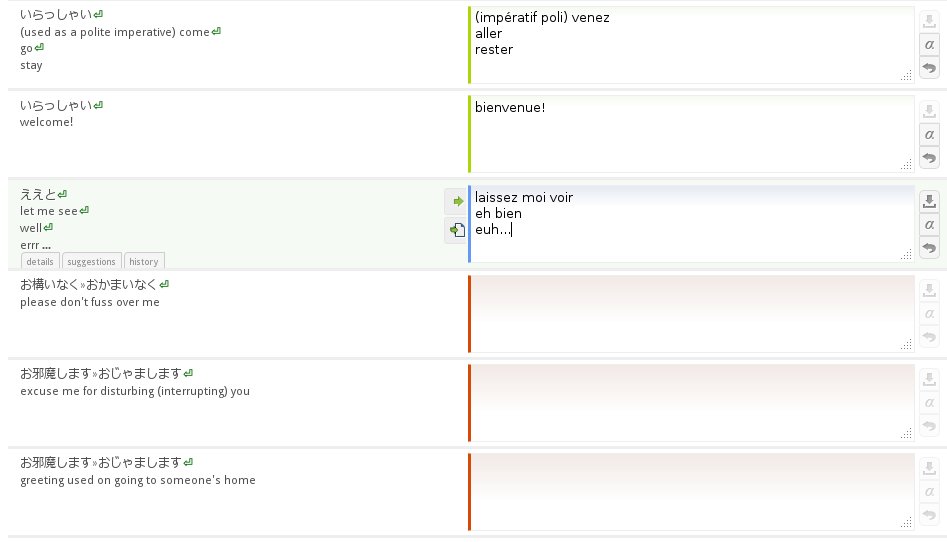JMdict/kanjidic2 internationalization project
What is it?
An effort to improve coverage of non-English languages in the JMdict and kanjidic2 dictionaries. These two dictionaries are the main sources of many Japanese-related open-source projects (Tagaini Jisho of course, but also jisho.org, JWPCE, etc.). They are invaluable resources for the student of Japanese, but unfortunately mostly limited to English, with translations in other languages incomplete and even sometimes incorrect. This effort aims at improving both the coverage and quality of these translations by involving the community.
How is it released? It is limited to Tagaini Jisho?
The project is still young. It will be released as an enriched, compatible version of the JMdict/kanjidic2. In the future, we hope to have them directly integrated into the original projects.
Although tagaini.net is used as a host for the project, the result is not limited to Tagaini Jisho. The data will be released under a Creative Commons Attribution licence.
How to participate?
The actual effort takes place on Transifex. There are two separate projects for JMdict and kanjidic2. We extract the Japanese words/kanji and English definitions as a source string, and ask contributors to translate the English meaning into their language.
Requirements
In order to maintain a high level of quality, we have a few requirements before accepting someone into a language team. Make sure you understand and can comply with them:
- You must have native level of the language you are translating into, and be capable of writing it without mistakes or spelling errors.
- You must understand English enough to avoid mistakes and ambiguities in your translations.
- It is a good idea to also understand Japanese to further limit the possibility of mistakes in your translation.
- Your translations will never go beyond the semantic range of the English translation. Sometimes you will find that a Japanese word has a wider meaning than the one expressed in its English translation. In such cases, please do not translate beyond that incomplete translation. The reason for that is that the same entry is present somewhere else, with other English meanings that complete the translation you are currently doing. Once again, please do not go beyond the semantic range of English as it will make the resulting data inaccurate.
Also, please subscribe to the following mailing list in order to receive important announcements: http://groups.google.com/group/jmdict-i18n
How to translate
Ready to participate? Great! Just register an account on Transifex and either ask to join an existing language team or to create a new one if no team exists for your language. You can then start translating a resource, preferably starting from the ones with a higher priority. Definitions to translate are indeed packed into “resources”, which are logical divisions of definitions according to their popularity and importance in study. They are also important for regression tracking (more on this later). Resources have a priority which gives an indication about the order in which they should be translated: highest-priority modules should be translated first.
For consistency purposes, translators should work on translating one module entirely before starting another one: this ensures that translations are made in a progressive manner and that most frequent entries are covered before less frequent ones. It also allows proper regression tracking to take place.
So, when you start translating a resource, you will reach the translation interface. On the left side, you will see the entry in Japanese and its English translation. On the right side, you are expected to enter the corresponding translation in your language:

Note that you must not copy the Japanese part into your translation - it is only here as a helper. Please write your translation using the English meanings as a guide, but using the original Japanese word as much as possible to avoid direct translation from English. As for the English translation, one line per meaning - but be aware that your translation does not need to have the same number of lines as the English one. If your language needs more of less definitions to express the same meaning, do what is best to ensure clarity.
Do not start the translation with a capital, unless the starting word requires it by rule. In general, try to follow the same format as the English translation.
Transifex gives you a very handy interface for translations. Using “tab” and “shift tab”, you can quickly move to the next or previous entries. By doing so, the translation you were doing will be automatically saved. If you meet an entry you are not sure about, don’t worry! Just skip it, and someone else will surely have an adequate translation for it.
Regressions and how to handle them
JMdict and kanjidic2 are both active projects: they evolve, get additions, corrections, and improvement from a community of linguists and translators. Sometimes the source string for an entry will change, and the translation may need to be updated as well. This is called a regression.
Regressions become visible in Transifex because they will suddently appear as untranslated. This is why it is important to ensure a resource is completely translated before going to the next one: this way, regressions can easily be spotted because its translation percentage will go down from 100% to 99% or less.
Although regressions appear as untranslated in Transifex, their previous translation is still carried into the release, and is still accessible in Transifex under the “suggestions” tab. When a regression occurs, the translator will most of the time just check that the translation still matches the source string, make some adjustments if needed, and record the updated string.
Got a few hundred entries translated? Fantastic! They will be part of the next release and will be used in Tagaini Jisho and hopefully many other projects.
What licence is the data released under?
In order to be fully compatible with JMdict and kanjidic2, all the data collected by this project is released under a Creative Commons Attribution-ShareAlike Licence (V3.0) licence.
